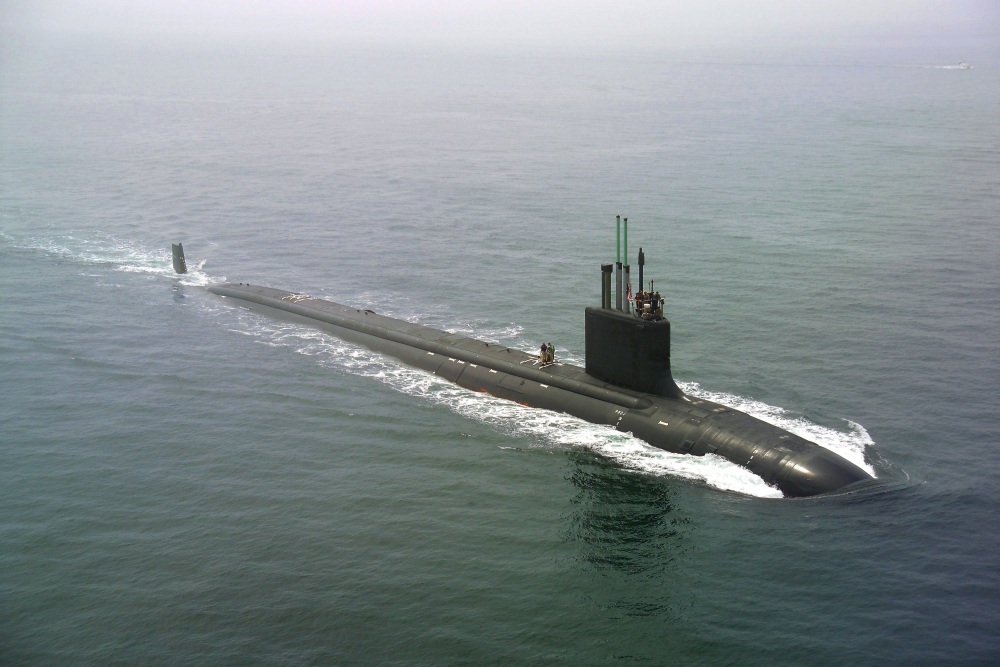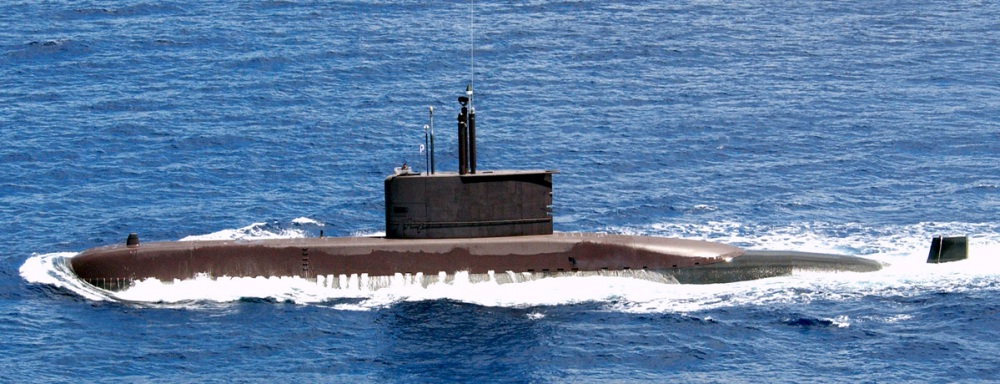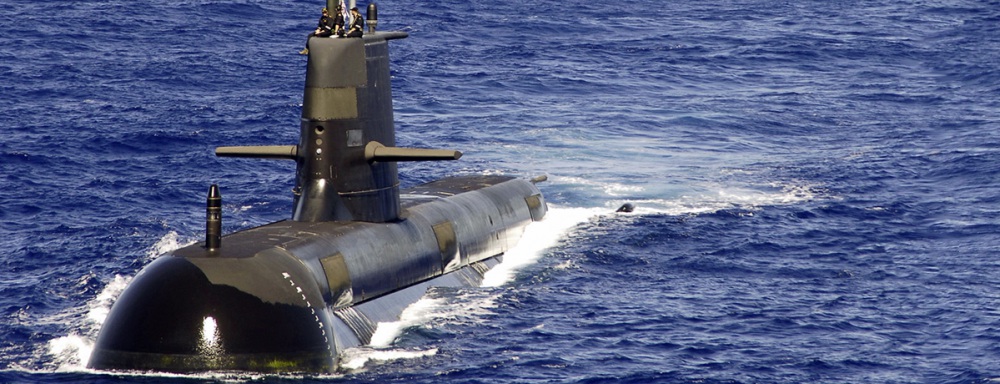Overview of the Submarine Proliferation Resource Collection
Part of Submarine Proliferation Resource Collection

About the image
Overview
The NTI Submarine Proliferation Resource Collection details the submarine capabilities and import/export behavior of several representative countries around the world. The collection focuses on technological improvements to global submarine fleets, such as the spread of nuclear propulsion and Air Independent Propulsion (AIP) technologies, which increase the capability of submarines to deliver weapons of mass destruction (WMD). Additionally, the collection tracks conventional submarine proliferation in potential global flashpoints, particularly the Middle East, South Asia, and Southeast Asia.
Submarine proliferation impacts both regional stability and the ability of states to deliver WMD. Since the end of the Cold War, the total number of active submarines in the world has fallen, largely as a result of large-scale decommissioning of former Soviet vessels. 1 However, the number of countries operating submarines has increased, due largely to ongoing regional tensions in the Middle East, South Asia, and East Asia. Countries that seek to acquire submarines can rely on a competitive global export market, which is only lightly regulated by international export controls.
An Evolving Export Market
Although the number of states acquiring submarines has grown in recent decades, the group of countries exporting submarines has remained relatively small. Today, France, Germany and Russia are the three most active exporters of conventional submarines. Between them, they have exported to more than 20 navies. 2 China has concluded submarine deals with countries such as Pakistan, Thailand, and Bangladesh, and appears to have greater aspirations in the export market. 3 South Korea has also entered the submarine export market, delivering its first Daewoo-built attack submarines to the Indonesian Navy in 2016. 4
Competition among exporters for lucrative construction contracts can be fierce, and this has often led to producers offering technology transfer to secure deals. One example is France’s production technology transfer to Brazil as part of its 2008 sale of Scorpène-class vessels. 5 Technology transfers of this kind will likely result in the proliferation of submarine producers as recipients become capable of constructing their own submarines.
AIP Technology
Air Independent Propulsion (AIP) technology provides diesel-powered submarines with greater submerged endurance (several weeks as opposed to several days), thereby enhancing survivability. 6 This is achieved through the use of liquid or compressed oxygen or hydrogen fuel cells that allow vessels to stay submerged for longer periods without surfacing. 7 AIP vessels are smaller than nuclear powered submarines, giving them greater access to shallow, littoral waters. For nations that are unable or unwilling to develop nuclear powered submarines, AIP offers an attractive alternative that improves submarine performance without the financial or political costs of nuclear propulsion.
Implications for Regional Stability
New capabilities for conventionally-powered submarines, such as AIP technology and cruise and ballistic missile delivery systems, have heightened concern that nuclear armed states outside the Treaty on the Non-Proliferation of Nuclear Weapons (NPT), such as Israel, India, and Pakistan, could mount nuclear warheads on submarine launched delivery systems. 8 Taking the example of the NPT-recognized nuclear weapon states, non-NPT nuclear weapon states hope to ensure the survival of their nuclear deterrent in the event of attack. Although such sea-based deployments may increase stability by ensuring a second-strike capability, they also have the potential to trigger arms races that create greater instability. Additionally, some experts are concerned that mounting nuclear weapons on submarines increases their vulnerability to unauthorized use or terrorist attack, and that states may lack sufficient command—and—control to reliably manage a submarine—based nuclear force. 9 The proliferation of conventional submarines, even among states that do not possess a nuclear weapons capability, may also precipitate regional arms races, especially in the Middle East and East Asia.
Nuclear Propulsion
Despite the advent of AIP technology, a number of states continue to pursue nuclear propulsion, often for reasons of national prestige or arms race dynamics. India and Brazil have taken significant steps toward this goal. After years of research and development, India officially commissioned its first nuclear-powered ballistic missile submarine, the INS Arinhart, in August 2016. 10 India has also leased a nuclear-powered attack submarine, the INS Chakra, from Russia. 11 By comparison, the development of Brazil’s nuclear-powered submarine lags far behind. 12 In their bids to develop nuclear propulsion, both India and Brazil have received assistance from other states. Russia has been India’s key partner, while France is assisting Brazil in constructing the hull for its first nuclear vessel.13
In 2023, the United States and United Kingdom agreed to equip Australia with nuclear-powered attack submarines (SSNs) to address perceived threats from China. The agreement included the U.S. sale of 3-5 Virginia-class SSNs, co-development by the UK and Australia of a new SSN, and a pledge by all three countries to expand their combined submarine industrial base. 14
Any spread of naval nuclear technology creates proliferation concerns due to a loophole in the Treaty on the Non-Proliferation of Nuclear Weapons (NPT). The naval nuclear propulsion loophole allows states to withdraw fissile material from international safeguards if it is to be used for military reactor fuel, thus creating the possibility that fissile material could be diverted to a nuclear weapons program. 15
Export Controls
When considering the export of submarines, states often prioritize financial gain over security concerns because of the lucrative nature of construction contracts. Russia’s provision of nuclear reactor and submarine-design technology to China and India are examples of this phenomenon. 16 Additionally, multilateral export control regimes contain few restrictions on the sale of submarines, partly because they have historically been used for defensive purposes. The UN Arms Register requires states to declare the transfer of warships that displace 500 metric tons, or are able to fire missiles or torpedoes with a range of 25 kilometers or more. 17 The Wassenaar Arrangement goes further by requiring states to report the sale of vessels that displace 150 tons, as well as those that are equipped to fire missiles or torpedoes with a range of 25 kilometers. 18 However, declarations to the United Nations have not been comprehensive, and neither of these regimes bans the sale of any type of submarine. 19 The NPT also allows the export of nuclear submarines, as nuclear propulsion is viewed as an acceptable use of nuclear energy. As a result, there is little to prevent states from selling submarines to countries located in regions of high political and military tension.
Explore the Collection
Your are currently on
Australia Submarine Capabilities
Brazil Submarine Capabilities
Chile Submarine Capabilities
China Submarine Capabilities
France Submarine Capabilities
Germany Submarine Capabilities
Greece Submarine Capabilities
India Submarine Capabilities
Indonesia Submarine Capabilities
Iran Submarine Capabilities
Israel Submarine Capabilities
Italy Submarine Capabilities
Japan Submarine Capabilities
Malaysia Submarine Capabilities
Netherlands Submarine Capabilities
North Korea Submarine Capabilities
Pakistan Submarine Capabilities
Russia Submarine Capabilities
Singapore Submarine Capabilities
South Korea Submarine Capabilities
Sweden Submarine Capabilities
Taiwan Submarine Capabilities
United States Submarine Capabilities
Submarine Detection and Monitoring: Open-Source Tools and Technologies
Stay Informed
Sign up for our newsletter to get the latest on nuclear and biological threats.
More on

Indonesia Submarine Capabilities
The Indonesian Navy, also known as Tentar Nasional Indonesia-Angkatan Laut (TNI-AL), operates two classes of submarines:

Australia Submarine Capabilities
A highlight of global trends in the sale and acquisition of diesel- and nuclear-powered submarines by country with capabilities, imports and exports. (CNS)
Brazil Submarine Capabilities
Global trends in the sale and acquisition of diesel- and nuclear-powered submarines by country with capabilities, imports and exports. (CNS)
Glossary
- Air Independent Propulsion Technology (AIP)
- Air Independent Propulsion Technology (AIP): A propulsion system that uses liquid (or compressed) oxygen or hydrogen fuel cells, thereby allowing submarines to stay submerged for longer periods without the need for external sources of oxygen. This increased endurance also increases a submarine’s survivability.
- WMD (weapons of mass destruction)
- WMD: Typically refers to nuclear, biological, or chemical weapons, though there is some debate as to whether chemical weapons qualify as weapons of “mass destruction.”
- Export control
- National laws or international arrangements established to restrict the sale of certain goods to certain countries, or to ensure that safeguards or end-use guarantees are applied to the export and sale of sensitive and dual-use technologies and materials. See entry for Dual-use
- Cruise missile
- An unmanned self-propelled guided vehicle that sustains flight through aerodynamic lift for most of its flight path. There are subsonic and supersonic cruise missiles currently deployed in conventional and nuclear arsenals, while conventional hypersonic cruise missiles are currently in development. These can be launched from the air, submarines, or the ground. Although they carry smaller payloads, travel at slower speeds, and cover lesser ranges than ballistic missiles, cruise missiles can be programmed to travel along customized flight paths and to evade missile defense systems.
- Ballistic missile
- A delivery vehicle powered by a liquid or solid fueled rocket that primarily travels in a ballistic (free-fall) trajectory. The flight of a ballistic missile includes three phases: 1) boost phase, where the rocket generates thrust to launch the missile into flight; 2) midcourse phase, where the missile coasts in an arc under the influence of gravity; and 3) terminal phase, in which the missile descends towards its target. Ballistic missiles can be characterized by three key parameters - range, payload, and Circular Error Probable (CEP), or targeting precision. Ballistic missiles are primarily intended for use against ground targets.
- Nuclear-weapon states (NWS)
- NWS: As defined by Article IX, paragraph 3 of the Treaty on the Non-Proliferation of Nuclear Weapons (NPT), the five states that detonated a nuclear device prior to 1 January 1967 (China, France, the Soviet Union, the United Kingdom, and the United States). Coincidentally, these five states are also permanent members of the UN Security Council. States that acquired and/or tested nuclear weapons subsequently are not internationally recognized as nuclear-weapon states.
- Treaty on the Non-Proliferation of Nuclear Weapons (NPT)
- The NPT: Signed in 1968, the Treaty on the Non-Proliferation of Nuclear Weapons (NPT) is the most widely adhered-to international security agreement. The “three pillars” of the NPT are nuclear disarmament, nonproliferation, and peaceful uses of nuclear energy. Article VI of the NPT commits states possessing nuclear weapons to negotiate in good faith toward halting the arms race and the complete elimination of nuclear weapons. The Treaty stipulates that non-nuclear-weapon states will not seek to acquire nuclear weapons, and will accept International Atomic Energy Agency safeguards on their nuclear activities, while nuclear weapon states commit not to transfer nuclear weapons to other states. All states have a right to the peaceful use of nuclear energy, and should assist one another in its development. The NPT provides for conferences of member states to review treaty implementation at five-year intervals. Initially of a 25-year duration, the NPT was extended indefinitely in 1995. For additional information, see the NPT.
- Non-nuclear weapon state (NNWS)
- Non-nuclear weapon state (NNWS): Under the Treaty on the Non-Proliferation of Nuclear Weapons (NPT), NNWS are states that had not detonated a nuclear device prior to 1 January 1967, and who agree in joining the NPT to refrain from pursuing nuclear weapons (that is, all state parties to the NPT other than the United States, the Soviet Union/Russia, the United Kingdom, France, and China).
- Deterrence
- The actions of a state or group of states to dissuade a potential adversary from initiating an attack or conflict through the credible threat of retaliation. To be effective, a deterrence strategy should demonstrate to an adversary that the costs of an attack would outweigh any potential gains. See entries for Extended deterrence and nuclear deterrence.
- Deployment
- The positioning of military forces – conventional and/or nuclear – in conjunction with military planning.
- Ballistic missile
- A delivery vehicle powered by a liquid or solid fueled rocket that primarily travels in a ballistic (free-fall) trajectory. The flight of a ballistic missile includes three phases: 1) boost phase, where the rocket generates thrust to launch the missile into flight; 2) midcourse phase, where the missile coasts in an arc under the influence of gravity; and 3) terminal phase, in which the missile descends towards its target. Ballistic missiles can be characterized by three key parameters - range, payload, and Circular Error Probable (CEP), or targeting precision. Ballistic missiles are primarily intended for use against ground targets.
- Fissile material
- Fissile material: A type of fissionable material capable of sustaining a chain reaction by undergoing fission upon the absorption of low-energy (or thermal) neutrons. Uranium-235, Plutonium-239, and Uranium-233 are the most prominently discussed fissile materials for peaceful and nuclear weapons purposes.
- Safeguards
- Safeguards: A system of accounting, containment, surveillance, and inspections aimed at verifying that states are in compliance with their treaty obligations concerning the supply, manufacture, and use of civil nuclear materials. The term frequently refers to the safeguards systems maintained by the International Atomic Energy Agency (IAEA) in all nuclear facilities in non-nuclear weapon state parties to the NPT. IAEA safeguards aim to detect the diversion of a significant quantity of nuclear material in a timely manner. However, the term can also refer to, for example, a bilateral agreement between a supplier state and an importer state on the use of a certain nuclear technology.
See entries for Full-scope safeguards, information-driven safeguards, Information Circular 66, and Information Circular 153. - Multilateral
- Multilateral: Negotiations, agreements or treaties that are concluded among three or more parties, countries, etc.
- Wassenaar Arrangement (WA)
- Representatives of 33 states met in Vienna, Austria in July 1996, and established this arrangement intended to contribute to regional and international security by promoting transparency and greater responsibility with regard to transfers of conventional arms and dual-use goods and technologies. This organization was the successor to the Coordinating Committee for Multilateral Export Controls (COCOM). See entry for COCOM. For additional information, see the Wassenaar Arrangement.
- Nuclear energy
- Nuclear energy: The energy liberated by a nuclear reaction (fission or fusion), or by radioactive decay.
Sources
- James Clay Moltz, "Global Submarine Proliferation: Emerging Trends and Problems," Nuclear Threat Initiative Issue Brief, March 2006, www.nti.org.
- "Our Submarines," Thyssenkrupp, thyssenkrupp-marinesystems.com; Pierre Tran, "DCNS Pins Hopes on Exports," Defense News, 8 November 2010, www.defensenews.com.
- Chen Qingqing, “China exporting more submarines,” Global Times, 27 March 2017, Globaltimes.cn.
- Franz-Stefan Gady, “South Korea Launches 2nd Indonesian Attack Submarine,” The Diplomat, 24 October 2016, https://thediplomat.com.
- “Brazil and France in Deal for SSKs, SSN,” Defense Industry Daily, 12 December 2014, www.defenseindustrydaily.com.
- Milan Vego, “The Right Submarine for Lurking in the Littorals,” U.S. Naval Institute, Proceedings Magazine, June 2010, Vol. 136, p. 6.
- “Sub Proliferation Sends Navies Diving for Cover,” Jane’s International Defence Review, 1 August 1997.
- James Clay Moltz, “Serious Gaps Emerging in Export Controls on Submarines,” NIS Export Control Observer, produced by the James Martin Center for Nonproliferation Studies, June 2005, p. 23.
- Ankit Panda and Vipin Narang, “Pakistan Tests New Sub-Launched Nuclear-Capable Cruise Missile. What Now?” The Diplomat, 10 January 2017, https://thediplomat.com.
- Stefan Gady, “India Quietly Commissions Deadliest Sub,” The Diplomat, 19 October 2017, www.thediplomat.com.
- “India to get Russian nuclear submarine for 10-year lease,” RIA Novosti, 17 March 2010, www.rian.ru.
- Nathan Gain, “Brazil’s PROSUB Submarine Development Program Marks New Milestones,” Naval News, 29 October 2020, www.navalnews.com; Xavier Vavasseur, “PROSUB Milestone: Brazilian Navy Approves Basic Design of SN-BR Submarine,” Naval News, 3 December 2020, www.navalnews.com.
- “[Prosub] The Riacheuelo completes her first dive underway!” Naval Group, 2 December 2020, naval-group.com; “Acordo Entre o Governo da República Federativa do Brasil e o Governo da República Francesa na Area de Submarinos” [Agreement Between the Government of the Federative Republic of Brazil and the Government of France in the Area of Submarines], Brazilian Defense Ministry, 23 December 2008, www.defesanet.com.br; Xavier Vavasseur, “PROSUB Milestone: Brazilian Navy Approves Basic Design of SN-BR Submarine,” Naval News, 3 December 2020, www.navalnews.com.
- Ashley Townshend, “The AUKUS Submarine Deal Highlights a Tectonic Shift in the U.S.-Australia Alliance,” Carnegie Endowment for International Peace, 27 March 2023, https://carnegieendowment.org.
- Chunyan Ma and Frank von Hippel, “Ending the Production of Highly Enriched Uranium for Naval Reactors, Nonproliferation Review, Spring 2001, p. 87; Jeremy Kaplow, “The Canary in the Nuclear Submarine: Assessing the Nonproliferation Risk of the Naval Nuclear Propulsion Loophole,” Nonproliferation Review, 3 February 2016.
- James C. Bussert, “China Copies Russian Ship Technology for Use and Profit,” Signal Online, June 2008, www.afcea.org.
- “Considerations for Reducing the Benchmark Range for Torpedoes on Warships of Less Than 500 Metric Tons,” 2009 Group of Governmental Experts on the UN Register of Conventional Arms, United Nations Office of Disarmament Affairs, www.un.org.
- “Wassenaar Arrangement on Export Controls for Conventional Arms and Dual-Use Goods and Technologies, Public Documents Volume I” December 2019, www.wasenaar.org.
- James Clay Moltz, “Serious Gaps Emerging in Export Controls on Submarines,” NIS Export Control Observer, produced by the James Martin Center for Nonproliferation Studies, June 2005, p. 24.
